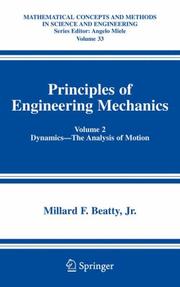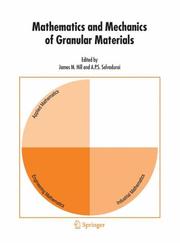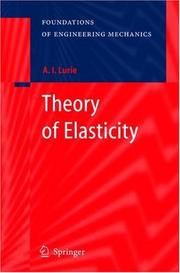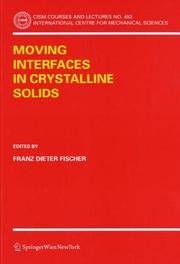| Listing 1 - 10 of 41 | << page >> |
Sort by
|
Book
ISBN: 9783211997093 9783211997086 Year: 2009 Publisher: Vienna : Springer-Verlag Vienna,
Abstract | Keywords | Export | Availability | Bookmark
 Loading...
Loading...Choose an application
- Reference Manager
- EndNote
- RefWorks (Direct export to RefWorks)
Many important industrial applications incline toward better understanding of the constitutive properties of matter. Nowadays, the development of measurement possibilities, even in nanoscale, allows for multiscale formulations that drive to the more sophisticated models used in continuum mechanics. These phenomenological models are particularly important and useful for solutions of very concrete initial boundary value problems. Our interests are focused mainly on detailed descriptions of material behavior that depend not only on simple stress-strain relationships but also includes the strong influence of loading type, which introduces temperature, strain rate dependence, fracture, etc. Understanding these physics phenomena is of fundamental importance for successful and responsible computations. In particular, using the popular commercial programs requires deep understanding of constitutive formulations and their restrictions. These lectures are addressed to industrial users who are responsible for making crucial decisions in design, as well as, to young scientists who work on new models that describe the behavior of materials which also account the new influences and reflect the complexity of the material behavior. At the end, let me express my gratitude to the lecturers of the CISM course No. 328 on Advances in Constitutive Relations Applied in Computer Codes , held in Udine in July 2007, who finally prepared the included materials. Unfortunately, during the preparation and collecting papers for this book, our friend and colleague Prof. Janusz R. Klepaczko passed away. This is a very big loss for the society of mechanics.
Engineering. --- Theoretical and Applied Mechanics. --- Engineering Design. --- Automotive Engineering. --- Engineering. --- Mechanics, applied. --- Engineering design. --- Ingénierie --- Conception technique
Book
ISBN: 9781441963796 9781441963789 Year: 2010 Publisher: New York, NY Springer New York
Abstract | Keywords | Export | Availability | Bookmark
 Loading...
Loading...Choose an application
- Reference Manager
- EndNote
- RefWorks (Direct export to RefWorks)
Computational Methods in Elasticity and Plasticity: Solids and Porous Media presents the latest developments in the area of elastic and elasto-plastic finite element modeling of solids, porous media and pressure-dependent materials and structures. The book covers the following topics in depth: the mathematical foundations of solid mechanics, the finite element method for solids and porous media, the theory of plasticity and the finite element implementation of elasto-plastic constitutive models. The book also includes: -A detailed coverage of elasticity for isotropic and anisotropic solids. -A detailed treatment of nonlinear iterative methods that could be used for nonlinear elastic and elasto-plastic analyses. -A detailed treatment of a kinematic hardening von Mises model that could be used to simulate cyclic behavior of solids. -Discussion of recent advances in the analysis of porous media and pressure-dependent materials in more detail than other books currently available. Computational Methods in Elasticity and Plasticity: Solids and Porous Media also contains problem sets, worked examples and a solutions manual for instructors.
Engineering. --- Theoretical and Applied Mechanics. --- Continuum Mechanics and Mechanics of Materials. --- Computational Mathematics and Numerical Analysis. --- Engineering. --- Computer science --- Mechanics, applied. --- Materials. --- Ingénierie --- Informatique --- Matériaux --- Mathematics. --- Mathématiques
Book
ISBN: 9783540899372 9783540899365 9783642128851 9783642140181 3642128858 Year: 2009 Publisher: Heidelberg Springer
Abstract | Keywords | Export | Availability | Bookmark
 Loading...
Loading...Choose an application
- Reference Manager
- EndNote
- RefWorks (Direct export to RefWorks)
Statics is the first volume of a three-volume textbook on Engineering Mechanics. It was written with the intention of presenting to engineering students the basic concepts and principles of mechanics in as simple a form as the subject allows. A second objective of this book is to guide the students in their efforts to solve problems in mechanics in a systematic manner. The simple approach to the theory of mechanics allows for the different educational backgrounds of the students. Another aim of this book is to provide engineering students as well as practising engineers with a basis to help them bridge the gaps between undergraduate studies, advanced courses on mechanics and practical engineering problems. The book contains numerous examples and their solutions. Emphasis is placed upon student participation in solving the problems. The contents of the book correspond to the topics normally covered in courses on basic engineering mechanics at universities and colleges. Volume 2 deals with Mechanics of Materials; Volume 3 contains Particle Dynamics and Rigid Body Dynamics.
Engineering. --- Theoretical and Applied Mechanics. --- Mechanics, applied. --- Ingénierie --- 62 --- Engineering. Technology in general --- Engineering --- Mechanics, Applied --- Materials --- Mechanical engineering --- Statics --- Mathematics --- Mechanics --- Mechanics, Analytic --- Physics --- Dynamics --- Equilibrium
Book
ISBN: 9780387776743 9780387569284 9780387776736 9781461424826 0387776737 0387776745 9786613511263 1280002921 Year: 2010 Publisher: Boston (Mass.) Springer US
Abstract | Keywords | Export | Availability | Bookmark
 Loading...
Loading...Choose an application
- Reference Manager
- EndNote
- RefWorks (Direct export to RefWorks)
Applied Plasticity, Second Edition, covers advanced topics in plasticity comprehensively and in detail. This new edition has been updated throughout and includes a large set of homework problems for each chapter, making it ideal for classroom use. All relevant topics are covered, including the mathematical theory of plasticity, the theory of plane plastic stress, the axially symmetrical plastic state, the plastic behavior of plates and shells, the plasticity of metal forming processes, the theory of buckling in the plastic range, topics in dynamic plasticity, and the finite element method. Features of the new edition include: A full chapter on the Finite Element Method, previously published as an appendix; A new section on yield line theory for plate bending, including the estimation of upper bounds on the limit load; Updated chapters throughout to reflect recent advances and new developments in the field; Homework problems for chapters one through eight; A solutions manual available to professors; Fully updated references. Applied Plasticity, Second Edition, is appropriate for use by graduate students studying mechanical, civil, and structural engineering, as well as applied mechanics, and will also serve as a useful reference for engineers working in these fields.
Classical mechanics. Field theory --- Solid state physics --- Applied physical engineering --- Engineering sciences. Technology --- toegepaste mechanica --- ingenieurswetenschappen --- mechanica --- Plastic analysis (Engineering) --- Plasticity. --- Mechanics. --- Mechanics, Applied. --- Mechanical engineering. --- Solid Mechanics. --- Theoretical and Applied Mechanics. --- Mechanical Engineering. --- Applied mechanics --- Engineering, Mechanical --- Engineering mathematics --- Engineering --- Machinery --- Steam engineering --- Classical mechanics --- Newtonian mechanics --- Physics --- Dynamics --- Quantum theory
Book
ISBN: 9783642053702 9783642053696 Year: 2010 Publisher: Berlin : Springer,
Abstract | Keywords | Export | Availability | Bookmark
 Loading...
Loading...Choose an application
- Reference Manager
- EndNote
- RefWorks (Direct export to RefWorks)
This book covers all topics in mechanics from elementary Newtonian mechanics, the principles of canonical mechanics and rigid body mechanics to relativistic mechanics and nonlinear dynamics. It was among the first textbooks to include dynamical systems and deterministic chaos in due detail. As compared to the previous editions the present fifth edition is updated and revised with more explanations, additional examples and sections on Noether's theorem. Symmetries and invariance principles, the basic geometric aspects of mechanics as well as elements of continuum mechanics also play an important role. The book will enable the reader to develop general principles from which equations of motion follow, to understand the importance of canonical mechanics and of symmetries as a basis for quantum mechanics, and to get practice in using general theoretical concepts and tools that are essential for all branches of physics. The book contains more than 120 problems with complete solutions, as well as some practical examples which make moderate use of personal computers. This will be appreciated in particular by students using this textbook to accompany lectures on mechanics. The book ends with some historical notes on scientists who made important contributions to the development of mechanics.
Physics. --- Mechanics. --- Theoretical and Applied Mechanics. --- Applications of Mathematics. --- Mathematical Methods in Physics. --- Dynamical Systems and Ergodic Theory. --- Differentiable dynamical systems. --- Mathematics. --- Mathematical physics. --- Mechanics, applied. --- Physique --- Dynamique différentiable --- Mathématiques --- Physique mathématique --- Mécanique --- Mechanics, Applied --- Deterministic chaos.

ISBN: 9780387312552 0387237046 9780387237046 1441936564 9786613438119 0387312552 1283438119 Year: 2006 Volume: 32-33 Publisher: New York, NY : Springer US : Imprint: Springer,
Abstract | Keywords | Export | Availability | Bookmark
 Loading...
Loading...Choose an application
- Reference Manager
- EndNote
- RefWorks (Direct export to RefWorks)
Separation of the elements of classical mechanics into kinematics and dynamics is an uncommon tutorial approach, but the author uses it to advantage in this two-volume set. Students gain a mastery of kinematics first – a solid foundation for the later study of the free-body formulation of the dynamics problem. A key objective of these volumes, which present a vector treatment of the principles of mechanics, is to help the student gain confidence in transforming problems into appropriate mathematical language that may be manipulated to give useful physical conclusions or specific numerical results. In the first volume, the elements of vector calculus and the matrix algebra are reviewed in appendices. Unusual mathematical topics, such as singularity functions and some elements of tensor analysis, are introduced within the text. A logical and systematic building of well-known kinematic concepts, theorems, and formulas, illustrated by examples and problems, is presented offering insights into both fundamentals and applications. Problems amplify the material and pave the way for advanced study of topics in mechanical design analysis, advanced kinematics of mechanisms and analytical dynamics, mechanical vibrations and controls, and continuum mechanics of solids and fluids. Volume I of Principles of Engineering Mechanics provides the basis for a stimulating and rewarding one-term course for advanced undergraduate and first-year graduate students specializing in mechanics, engineering science, engineering physics, applied mathematics, materials science, and mechanical, aerospace, and civil engineering. Professionals working in related fields of applied mathematics will find it a practical review and a quick reference for questions involving basic kinematics.
Mechanics, Applied. --- Kinematics. --- Mécanique appliquée --- Cinématique --- EPUB-LIV-FT LIVMATHE LIVSTATI SPRINGER-B --- Engineering. --- Applied mathematics. --- Engineering mathematics. --- Mechanics. --- Mechanical engineering. --- Mechanical Engineering. --- Theoretical and Applied Mechanics. --- Engineering, general. --- Applications of Mathematics. --- Applied mechanics --- Engineering, Mechanical --- Engineering mathematics --- Mathematics --- Mechanics --- Motion --- Mechanics, applied. --- Mathematics. --- Math --- Science --- Construction --- Industrial arts --- Technology --- Engineering --- Machinery --- Steam engineering --- Engineering analysis --- Mathematical analysis --- Classical mechanics --- Newtonian mechanics --- Physics --- Dynamics --- Quantum theory

ISBN: 9781402041839 9781402037818 1402037813 904816964X 9786610412174 1280412178 1402041837 Year: 2005 Publisher: Dordrecht Springer
Abstract | Keywords | Export | Availability | Bookmark
 Loading...
Loading...Choose an application
- Reference Manager
- EndNote
- RefWorks (Direct export to RefWorks)
Granular or particulate materials arise in almost every aspect of our lives, including many familiar materials such as tea, coffee, sugar, sand, cement and powders. At some stage almost every industrial process involves a particulate material, and it is usually the cause of the disruption to the smooth running of the process. In the natural environment, understanding the behaviour of particulate materials is vital in many geophysical processes such as earthquakes, landslides and avalanches. This book is a collection of current research from some of the major contributors in the topic of modelling the behaviour of granular materials. Papers from every area of current activity are included, such as theoretical, numerical, engineering and computational approaches. This book illustrates the numerous diverse approaches to one of the outstanding problems of modern continuum mechanics.
toegepaste mechanica --- Fluid mechanics --- mechanica --- Engineering sciences. Technology --- ingenieurswetenschappen --- Classical mechanics. Field theory --- Granular materials --- Bulk solids flow --- Matériaux granulaires --- Vrac --- Mathematical models --- Fluid dynamics --- Modèles mathématiques --- Dynamique des fluides --- Ecoulement --- EPUB-LIV-FT SPRINGER-B --- Mechanics. --- Mechanical engineering. --- Mechanics, applied. --- Mechanics, Applied. --- Classical Mechanics. --- Mechanical Engineering. --- Theoretical and Applied Mechanics. --- Solid Mechanics. --- Applied mechanics --- Engineering, Mechanical --- Engineering mathematics --- Engineering --- Machinery --- Steam engineering --- Classical mechanics --- Newtonian mechanics --- Physics --- Dynamics --- Quantum theory --- Mathematical models.

ISBN: 9783540264552 3540245561 9783540245568 9786613250667 3540264558 1283250667 Year: 2005 Publisher: Berlin ; New York : Springer,
Abstract | Keywords | Export | Availability | Bookmark
 Loading...
Loading...Choose an application
- Reference Manager
- EndNote
- RefWorks (Direct export to RefWorks)
This invaluable treatise belongs to the cultural heritage of mechanics. It is an encyclopaedia of the classic and analytic approaches of continuum mechanics and of many domains of natural science. The book is unique also because an impressive number of methods and approaches it displays have been worked out by the author himself. In particular, this implies a full consistency of notation, ideas and mathematical apparatus which results in a unified approach to a broad class of problems. The book is of great interest for engineers who will find a lot of analytical formulae for very different problems covering nearly all aspects of the elastic behavior of materials. In particular, it fills the gap between the well-developed numerical methods and sophisticated methods of elasticity theory. It is also intended for researchers and students taking their first steps in continuum mechanics as it offers a carefully written and logically substantiated basis of both linear and nonlinear continuum mechanics.
Engineering. --- Theoretical and Applied Mechanics. --- Computational Intelligence. --- Mechanics. --- Mechanics, applied. --- Ingénierie --- Mécanique --- Elastic. --- Elastic solids. --- Elasticity -- Congresses. --- Elasticity. --- Elasticity --- Continuum mechanics --- Civil Engineering --- Applied Mathematics --- Civil & Environmental Engineering --- Engineering & Applied Sciences --- Continuum mechanics. --- Mechanics of continua --- Elastic properties --- Young's modulus --- Computational intelligence. --- Mechanics, Applied. --- Mechanical engineering. --- Mechanical Engineering. --- Engineering, Mechanical --- Engineering --- Machinery --- Steam engineering --- Applied mechanics --- Engineering mathematics --- Intelligence, Computational --- Artificial intelligence --- Soft computing --- Classical mechanics --- Newtonian mechanics --- Physics --- Dynamics --- Quantum theory --- Construction --- Industrial arts --- Technology --- Mechanics, Analytic --- Field theory (Physics) --- Mathematical physics --- Matter --- Statics --- Rheology --- Strains and stresses --- Strength of materials --- Properties --- Classical Mechanics.

ISBN: 3211274049 9783211274040 3211238999 9783211238998 Year: 2005 Publisher: Vienna : Springer Vienna : Imprint: Springer,
Abstract | Keywords | Export | Availability | Bookmark
 Loading...
Loading...Choose an application
- Reference Manager
- EndNote
- RefWorks (Direct export to RefWorks)
Moving Interfaces in Solids are typically phase boundaries and grain or subgrain boundaries. Continuum thermodynamics and continuum mechanics are applied to explain the motion process. Related numerical and experimental concepts are dealt with. Experts from material physics and mechanics bridge the gap between these fields. The reader is offered a common view of interface mtion in a unique representation. Examples are presented for various material systems.
Interfaces (Physical sciences) --- Solids --- Surfaces. --- Interfaces (Physical sciences). --- Solids -- Surfaces. --- Engineering. --- Continuum mechanics. --- Continuum Mechanics and Mechanics of Materials. --- Surface chemistry --- Surfaces (Physics) --- Mechanics. --- Mechanics, Applied. --- Solid Mechanics. --- Applied mechanics --- Engineering, Mechanical --- Engineering mathematics --- Classical mechanics --- Newtonian mechanics --- Physics --- Dynamics --- Quantum theory
Book
ISBN: 9781402065774 1402065760 9781402065767 9048176727 9786612823510 1402065779 1282823515 Year: 2007 Publisher: Dordrecht : Springer,
Abstract | Keywords | Export | Availability | Bookmark
 Loading...
Loading...Choose an application
- Reference Manager
- EndNote
- RefWorks (Direct export to RefWorks)
Despite the apparent activity in the field, the ever increasing rate of development of new engineering materials required to meet advanced technological needs poses fresh challenges in the field of constitutive modelling. The complex behaviour of such materials demands a closer interaction between numerical analysts and material scientists in order to produce thermodynamically consistent models which provide a response in keeping with fundamental micromechanical principles and experimental observations. This necessity for collaboration is further highlighted by the continuing remarkable developments in computer hardware which makes the numerical simulation of complex deformation responses increasingly possible. This book contains 14 invited contributions written by distinguished authors who participated in the VIII International Conference on Computational Plasticity held at CIMNE/UPC (www.cimne.com) from 5-8 September 2005, Barcelona, Spain. The meeting was one of the Thematic Conferences of the European Community on Computational Methods in Applied Sciences (ECCOMAS, www.eccomas.org). The different chapters of this book present recent progress and future research directions in the field of computational plasticity. A common line of many contributions is that a stronger interaction between the phenomenological and micromechanical modelling of plasticity behaviour is apparent and the use of inverse identification techniques is also more prominent. The development of adaptive strategies for plasticity problems continues to be a challenging goal, while it is interesting to note the permanence of element modelling as a research issue. Industrial forming processes, geomechanics, steel and concrete structures form the core of the applications of the different numerical methods presented in the book.
Engineering. --- Computational Intelligence. --- Structural Mechanics. --- Building Construction, HVAC, Refrigeration. --- Mechanical engineering. --- Building construction. --- Ingénierie --- Génie mécanique --- Plasticity -- Mathematical models. --- Plasticity. --- Strength of materials. --- Engineering & Applied Sciences --- Applied Mathematics --- Computer Science --- Plasticity --- Mathematical models. --- Data processing. --- Computational intelligence. --- Mechanics. --- Mechanics, Applied. --- Structural mechanics. --- Buildings --- Building. --- Construction. --- Engineering, Architectural. --- Theoretical and Applied Mechanics. --- Building Construction. --- Design and construction. --- Building --- Architectural engineering --- Construction --- Construction science --- Engineering, Architectural --- Structural design --- Structural engineering --- Architecture --- Construction industry --- Structural mechanics --- Structures, Theory of --- Applied mechanics --- Engineering, Mechanical --- Engineering mathematics --- Classical mechanics --- Newtonian mechanics --- Physics --- Dynamics --- Quantum theory --- Intelligence, Computational --- Artificial intelligence --- Industrial arts --- Technology --- Design and construction --- Soft computing --- Cohesion --- Deformations (Mechanics) --- Elasticity --- Plastics --- Rheology --- Mechanics, applied. --- Solid Mechanics. --- Building Construction and Design. --- Buildings—Design and construction.
| Listing 1 - 10 of 41 | << page >> |
Sort by
|

 Search
Search Feedback
Feedback About UniCat
About UniCat  Help
Help News
News